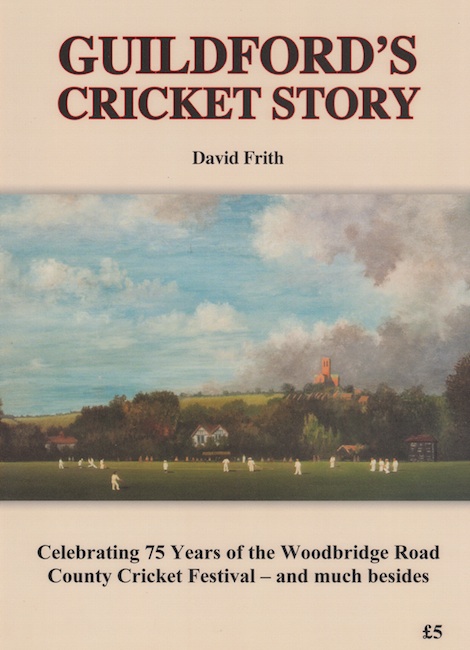 Abraham Lincoln
If given the truth, the people can be depended upon to meet any national crisis...
Abraham Lincoln
If given the truth, the people can be depended upon to meet any national crisis...
 Guildford news...
for Guildford people, brought to you by Guildford reporters - Guildford's own news service
Guildford news...
for Guildford people, brought to you by Guildford reporters - Guildford's own news service
Guildford is Cricket’s True Cradle Claims Renowned Cricket Writer
Published on: 15 Aug, 2013
Updated on: 23 Aug, 2013
David Frith, respected cricket commentator and writer, former editor of Wisden magazine and Guildford resident, launches a long-overdue claim for Guildford to be regarded as cricket’s premier source of development.
For a very long time now the Hampshire village of Hambledon has been known as the “Cradle of Cricket”.
This is largely because the area hosted major cricket matches on Broadhalfpenny Down in the late 18th century, and, most significantly, there was somebody there – John Nyren – astute enough to chronicle the matches and the star players of the day.
Cricket was flourishing 250 years ago in many other parts of England, principally in the south. But belatedly, when the “credits” are carefully listed, it is quite clear that our town of Guildford has to its credit the most significant of cricket landmarks.
To summarise: there is the earliest surviving record of the word “cricket” (spelt “creckett” in the 1598 court document, which was in the local archives until being taken to the Surrey History Centre in Woking). It refers to the game played by John Derrick and other boys at the Royal Grammar School around 1550. No earlier reference to the game exists.
Then we have local man Edward “Lumpy” Stevens, the champion (underhand) bowler of his time. So many times did he beat the batsman, only to see the ball pass through the two uprights (stumps), that those who controlled the game in the 18th century decided it was only fair to install a middle stump. Think of that next time you see Chris Tremlett sending the middle stump flying past the wicketkeeper’s ear.
From Ash came Bob Robinson, a visionary who decided he’d had enough of getting his shins chipped and bruised by the ball. He invented the first leg protection for batsmen. Unfortunately it was made from timber slats and made a ridiculous noise when hit by the ball. He was laughed off the pitch. But it was a beginning towards the sophisticated leg-guards of today.
Robinson caused further reaction when he devised the first spikes, attached to the soles of his boots. The damage to the pitch was so alarming that this idea too was abandoned – but only temporarily. It wasn’t long before acceptable spikes were introduced. This was another first for the Guildford area, where many of the “great” matches of the late 1700s were played at Merrow Down, an area now occupied by Guildford Golf Club.
Also from Ash came Will Hammersley, who went off to Australia as a young man, and placed his mark on cricket history by coining the expression “test match”. This was in 1862, when the first English cricket team toured Australia. (George Griffith, from Stoughton, was a member of that pioneering team. He was to hang himself in 1879 and is buried in Stoke churchyard.
And not least significantly, flying the flag for half the human race, the ladies of Bramley played against a team of ladies from Hambleton way back in 1745, the first-ever properly organised women’s cricket match.
It’s a powerful list of cricket firsts for Guildford, and the area should be proud of it, for there is nothing to match it. It’s just surprising that it’s taken so long to become aware of this phenomenon.
GUILDFORD’S CRICKET STORY by David Frith: published at £5 plus £2 p&p by Guildford Cricket Club, Woodbridge Road pavilion (orders via the club website). Also available at Guildford Museum in Quarry Street.
A few copies remain of a special hardback limited edition of only 40 numbered copies: £75 plus £5 p&p. These are signed by the author and by former Guildford cricketers Martin and Darren Bicknell, Ashley Giles and Rikki Clarke.
See also: Book Review: Guildford’s Cricket Story by David Frith
Recent Articles
- Guildford Institute’s Crowdfunding Project for Accessible Toilet in its New Community and Wellbeing Centre
- Letter: Guildford – Another Opportunity Missed?
- Letter: GBC’s Corporate Strategy – Where Is the Ambition?
- My Memories of John Mayall at a Ground-breaking Gig in Guildford Nearly Six Decades Ago
- Westborough HMO Plans ‘Losing the Heart of the Street’ Says Resident
- College Invests to Boost Surrey’s Economy and Close Digital Skills Gap
- Community Lottery Brings Big Wins for Local Charities
- GBC Housing Plan Promises ‘A Vibrant Urban Neighbourhood’ Near Town Centre
- Hospital Pillows ‘Shortage’ at the Royal Surrey
- Updated: Caravans Set Up Camp at Ash Manor School


Search in Site
Media Gallery
Dragon Interview: Local Artist Leaves Her Mark At One of England’s Most Historic Buildings
January 21, 2023 / No Comment / Read MoreDragon Interview: Lib Dem Planning Chair: ‘Current Policy Doesn’t Work for Local People’
January 19, 2023 / No Comment / Read MoreA3 Tunnel in Guildford ‘Necessary’ for New Homes, Says Guildford’s MP
January 10, 2023 / No Comment / Read More‘Madness’ for London Road Scheme to Go Ahead Against ‘Huge Opposition’, Says SCC Leader
January 6, 2023 / No Comment / Read MoreCouncillor’s Son Starts Campaign for More Consultation on North Street Plan
December 30, 2022 / No Comment / Read MoreCounty Council Climbs Down Over London Road Works – Further ‘Engagement’ Period Announced
December 14, 2022 / No Comment / Read MoreDragon Interview: GBC Reaction to the Government’s Expected Decision to Relax Housing Targets
December 7, 2022 / No Comment / Read MoreHow Can Our Town Centre Businesses Recover? Watch the Shop Front Debate
May 18, 2020 / No Comment / Read More











Recent Comments